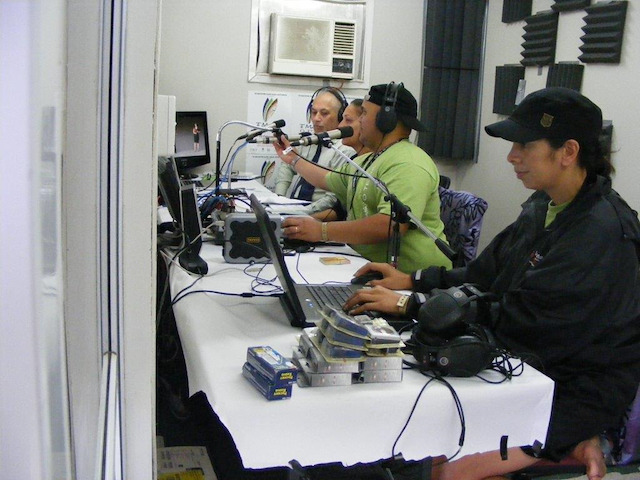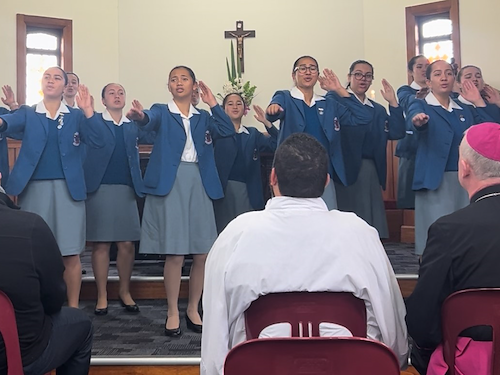Te Reo Māori is the indigenous language of Aotearoa, New Zealand. It is one of two official languages of the nation. The language itself is central to Māori culture, identity and forms part of the heritage of our country.
Last updated: Monday, 7 April 2025 | Rāhina, 07 Paengawhāwhā, 2025
What's on this page?

Rebecca Lelievre reading in te reo Māori to her son. Photo by Adrian Heke.
This page contains Te Reo Māori information and links to resources. For information about Te Ture mō Te Reo Māori (the Māori Language Act) 2016 and Te Puni Kōkiri work in leading the Māori Language Strategy visit Ā Mātou Whakaarotau.
History of te reo Māori
Te reo Māori has experienced a varied history, from being a language that was solely spoken in the early 1800s, to a complete reversal where English was prominent more widely in the mid 1900s. Despite the change in roles, the Māori language has survived and experienced revitalisation since the 1970s.
The resurgence in te reo Māori began during the 1970s. At a time when fewer families spoke Māori, fears were prevalent that it was dying out as an everyday language. In response, Māori language education initiatives such as Te Kōhanga Reo, Kura Kaupapa Māori and Te Ataarangi were created.
In 1987, the Māori Language Act was passed into legislation recognising te reo Māori as an official language of Aotearoa New Zealand. It also formed a body, known as Te Taura Whiri i te Reo Māori, the Māori Language Commission which promotes Māori as a living language and as an ordinary means of communication. Te Taura Whiri i te Reo Māori sets quality standards for written and spoken Māori, and provides research which informs policy related to the promotion, maintenance and growth of the Māori language.
Since then, the focus has widened to include Māori broadcasting, and subsequently led to the establishment of Te Māngai Pāho, the Māori Broadcasting Funding Agency.
Further developments include the establishment of, Whakaata Māori, the Māori Television Service in 2003. In 2008, a second Māori Television channel, Te Reo, was launched committed solely to broadcasting in Te Reo Māori.
In April 2016, Parliament passed The Māori Language Act 2016. This act established Te Mātāwai to lead revitalisation of te reo Māori on behalf of iwi and Māori. The Act is written in te reo Māori and English, with the Māori language text prevailing – a first for the New Zealand legal system.
The act includes an acknowledgement that the Crown’s past policies and practices concerning the Māori language have had a detrimental effect on generations of iwi and Māori.
Te Mātāwai met for the first time at Ōtaki in October 2016.
In August 2017, Rotorua became the first city in New Zealand to declare itself as bilingual in te reo Māori and English.
More on the timeline of te reo Māori is available on the Te Taura whiri i te reo Māori website here.
Te reo Māori statistics
Te Kupenga 2018 Māori wellbeing report released by Statistics New Zealand indicated that nearly 48 percent of Māori adults had some ability to speak Te Reo Māori (that is, they were able to speak more than a few words or phrases in the language). This is compared to 55 percent in 2013.
The report also showed nearly 6 out of 10 Māori adults (57 percent) could understand Te Reo Māori.
Attitudes towards the Māori language amongst Māori and non-Māori are improving. The Survey of Attitudes toward the Māori Language, undertaken for Te Puni Kōkiri in 2006, found that the Māori language currently enjoys a high status in Māori society, and positive acceptance by the majority of non-Māori New Zealanders
Te Mātāwai
Te Mātāwai is a new organisation established under Te Ture mō te Reo Māori 2016 (The Māori Language Act 2016) to lead revitalisation of te reo Māori on behalf of iwi and Māori.
Te Mātāwai will soon begin investing in iwi, hapū, whānau and community initiatives that focus on Māori language revitalisation in homes and communities.
Māori-English Bilingual Signage
The Māori-English Bilingual Signage: A guide for best practice is a resource produced by Te Puni Kōkiri and Te Taura Whiri i te Reo Māori to increase and improve bilingual signage throughout Aotearoa New Zealand.
The guide is packed full of good tips on how organisations can engage with Māori communities and support te reo Māori to be more visible through signage.
Te Reo Māori broadcasting

Te Māngai Pāho, Māori Broadcasting Funding Agency is a Crown Entity established to make funding available to the national network of Māori radio stations and for the production of Māori language television programmes, radio programmes, and music compilations.
Irirangi.net contains links and contact information to the network of 21 Māori radio stations.
Whakaata Māori, Māori Television is Aotearoa, New Zealand’s indigenous broadcaster, providing a wide range of local and international programmes for audiences across the country and online.
The Te Reo channel is a full service of 100 percent Māori language programme. The channel offers latest news and views, chat shows, and infotainment as well as sport and children’s shows. Te Reo channel is on SKYTV: channel 82 and Freeview: channel 15.
Te Reo Māori education - early learning and schools

This Ministry of Education factsheet provides more information and an overview to kaupapa Māori and Māori medium education and Education Counts includes statistical information about Māori Language in Education.
Te Kōhanga Reo is a movement which has established Māori language nests or centres for mokopuna and whānau. Te Kōhanga Reo National Trust Board was established in the early 1980s with a mission to protect te reo, tikanga me ngā āhuatanga Māori by targeting the participation of mokopuna and whānau into the Kōhanga Reo movement.
Other Māori immersion and/or bilingual options include puna reo (education and care centres) and ngā puna kōhungahunga (playgroups). Some kindergartens and home-based education and care services offer bilingual early childhood education as well. Information about early learning and ECE services can be found on this site for parents.
The Ministry of Education funds and licences all kōhanga reo and ECE services. Ngā puna kōhungahunga (playgroups) are not licensed but they can be certified to receive Government funding.
In the compulsory school sector some schools operate as kura kaupapa Māori and are aligned to Te Rūnanganui o Ngā Kura Kaupapa Māori. Other schools are formally aligned to local iwi (Kura Motuhake)
Education Counts has a directory of schools where all, or some, of their students are taught curriculum subjects in reo Māori for at least 51 percent of the time, and you can find contact details for these schools through Te Kete Ipurangi.
Wanting to learn Te Reo Māori?
Te Ataarangi has engaged Māori communities in learning the language in homes and on Marae since 1979. It has a number of Te Reo Māori learning programmes available across the county.
Many tertiary education organisations offer papers and courses in te reo Māori which are registered on the National Qualifications Framework. To find an education organisation in your region, go to the NZQA website.
You might also like to visit Te Whanake or Kōrero Māori for some Māori language learning resources.
Māori dictionaries online
Te Aka Māori-English, English-Māori Dictionary is an online Māori dictionary to complement its hard copy version.
The Ngata Dictionary illustrates the use of Māori and English headwords in sentences and phrases drawn from a wide range of contemporary and traditional contexts. It explains usage as well as meaning.
Looking for a translator?
Te Taura Whiri i te Reo Māori hosts a National Translators Register with the names of the people that were conferred with the Māori Translators and/or Interpreters Licence and were certified under Section 15(2) c of the Māori Language Act 1987.
Related News and Stories
Read our latest news and stories for this kaupapa.

Investing in the future of our Māori leaders
New dormitories and facilities at St Joseph’s Māori Girl's College have been lifted to the same high calibre as the school’s young achievers.

New te reo Māori speech competition - Waha Kōrero
Te Taura Whiri i te Reo Māori has launched a new speech competition - Waha Kōrero. There is only one week left to enter - maybe yourself or someone you know! Karawhiua e hoa mā!

UN countries adopt groundbreaking intellectual property treaty
Mātauranga Māori is central to te ao Māori and a major part of our unique culture and national identity in Aotearoa.

Matariki, whakanui at Te Papa Tongarewa
Matariki celebrations are taking place across the motu. Matariki is the cluster of stars that rise on the northeastern horizon in mid-winter and marks the Māori New Year.

Honours recognise those serving Māori
Twice a year, New Years and King’s Birthday, we recognise New Zealanders who have served and achieved in their respective passion, including those for their service to Māori.

Protecting Indigenous Knowledge – He Toa Takitini
Our Te Pae Tawhiti and Ōhanga (economic) policy teams in collaboration with indigenous intellectual property experts Local Contexts, brought together leaders and policy developers whose mahi helps protect indigenous knowledge around the world, including mātauranga Māori.